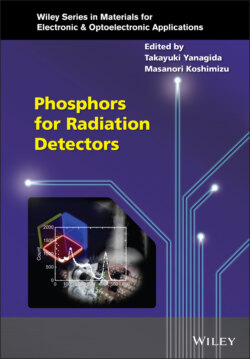Читать книгу Phosphors for Radiation Detectors - Группа авторов - Страница 11
Оглавление
Preface
The idea of writing this book was first proposed by Professor Safa Kasap of the University of Saskatchewan in 2019. Up to now, some books have been published focusing separately on scintillators or dosimeters. Although the purpose is the same, detection of ionizing radiation by luminescent materials, these two topics have been developed in different communities by different conferences and research groups. Recently, the inverse proportional relationship between scintillation and ionizing radiation‐induced storage luminescence for dosimeters has been introduced, and we feel that a text book treating these two topics comprehensively will be useful for people studying radiation detectors by using luminescent materials.
Luminescent materials for ionizing radiation detectors are mainly scintillators, thermally stimulated luminescent (TSL) materials, optically stimulated luminescence (OSL) materials which are sometimes called photo‐stimulated luminescence (PSL) materials, and radiophotoluminesnce (RPL) materials. Collectively, we call the latter three (TSL, OSL, and RPL) materials as dosimeter materials. Actually, these luminescent mechanisms at around localized luminescence centers are different from each other, but generation and transportation of electrons and holes are common to all. Thus, the determination item of scintillators and dosimeter materials is a branching ratio of carriers generated by ionizing radiation toward luminescence centers or trapping centers, and we can understand ionizing radiation‐induced luminescent phenomena and materials with clearer outlook by studying scintillators and dosimeter materials.
One of the features of the present book is not only the introduction of many scintillators and dosimeter materials but also description of a typical synthesis method. Such a synthesis method is categorized in chemistry, and such explanations will be useful for readers in related fields.
It should be noted that the dynamics of the excited states produced by ionizing radiation is different from those by optical excitation. The excited states dynamics should be considered in the wider scales of energy, space, and time. From the energy point of view, electrons having energies on the order of keV to MeV are generated by ionizing radiation. Subsequent generation of many secondary electrons results in the generation of lower‐energy excited states, i.e., generation of conduction electrons and holes in valence bands or deeper core levels. Subsequent energy transfer and radiative recombination results in scintillation, whereas charge trapping results in a TSL, OSL, or RPL. From the viewpoint of spatial distribution, blocking of X‐rays or gamma‐rays needs bulk materials of mm or cm. The transport of initial high‐energy electrons and secondary electrons should be considered. Energy transfer or charge trapping processes within the nanometer scale should also be considered. As for the dynamics in a wide time scale, generation of secondary electrons occurs within the ps order, energy transfer and charge trapping occur typically in the ns order, and radiative recombination occurs from ns to ms. The trapped electrons and holes survive from hour to day or month. To design novel materials with excellent properties, materials designed based on the understanding of the dynamical processes are desirable.
Chapter 1 describes some fundamental physics of inorganic scintillators and storage phosphors for ionizing radiation detectors, and following these fundamental topics constructed up to now, the idea and experimental confirmation of the complementary relationship of these materials will be explained.
Chapter 2 focuses on organic scintillators because an analytical model has been well established in chemical physics and photophysics fields, and is very useful for understanding luminescent mechanisms. The following two chapters treat the fundamental aspects, where we will move on to details of materials and properties.
Chapters 3, 4, and 5 focus on inorganic oxide, fluoride, and halide scintillators, respectively, since the number of inorganic scintillators is very large due to the large market size of practical applications. In addition to the introduction of common scintillators, typical synthesis methods are introduced.
Chapter 6 focuses on the semiconductor scintillator. In this chapter, a very hot topic, organic–inorganic layered perovskite materials for scintillation detectors are introduced.
From Chapter 7, the topic of the book moves to dosimeter (radiation‐induced storage phosphor) materials. In this chapter, TSL materials and common analysis methodology for TSL phenomenon are explained. Following this chapter, OSL (Chapter 8) and RPL (Chapter 9) are introduced.
In Chapter 10, transparent ceramics for scintillators and dosimeter materials are introduced. Recently, R&D of transparent ceramics for radiation detector is ongoing, and it is one of the hottest topics in related fields.
Chapter 11 focuses on glass materials. Glasses have been used for many optical applications, including luminescent devices. This chapter explains some fundamental aspects of glasses and materials for radiation detectors.
Chapter 12 introduces ionizing radiation detectors using luminescent materials, and how to measure ionizing radiation by luminescent materials is introduced.
This book is suitable for undergraduate and graduate students, whose major is radiation detection using phosphors. The content of this book is also helpful to engineers and young researchers in the field of radiation detection. To fully understand the contents of this book, it is desirable that readers understand solid state physics, quantum mechanics, and inorganic chemistry. Some key concepts are explained in Chapters 1 and 2. We hope that this book will be useful to all its readers.
Takayuki Yanagida & Masanori Koshimizu May 2021
